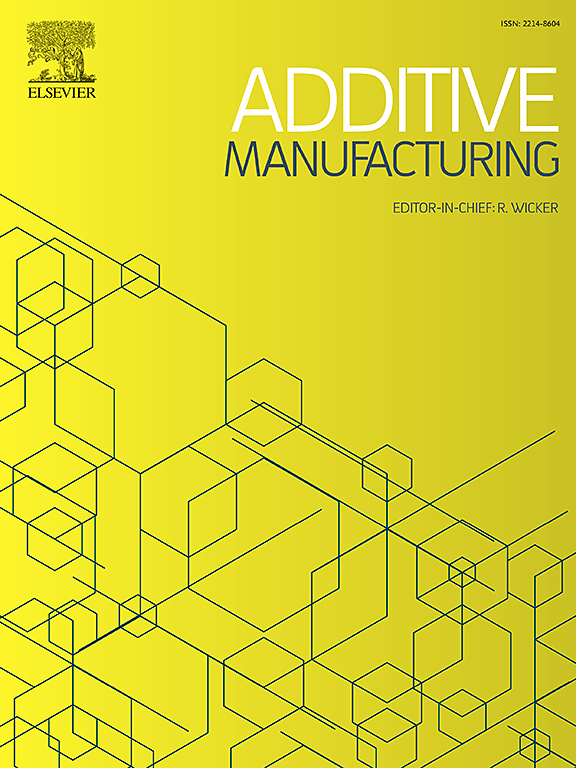Analytical prediction of lack-of-fusion porosity including uncertainty and variable melt pools for powder bed fusion
IF 10.3
1区 工程技术
Q1 ENGINEERING, MANUFACTURING
引用次数: 0
Abstract
Powder bed fusion (PBF) additive manufacturing (AM) technology has greatly matured in recent years driven by numerous industrial applications. However, lack-of-fusion (LoF) porosity is a significant challenge during PBF, and LoF pores can form even when processing with optimized deposition parameters. This paper proposes an analytical approach for simulating LoF porosity during PBF AM on the basis of a semi-elliptical model of the melt pool cross-section. Melted area, reference area, and LoF area fraction calculations are developed for the case where only one layer melts the reference area because of a shallow melt pool. In more complex cases where two layers melt a portion of the initial layer, the melted volume, reference volume, and LoF volume fraction calculations are developed using a change of coordinate system and integration. Finally, the model is extended to an arbitrary number of layers by assuming LoF porosity exponentially decays as the number of interacting layers increases. The analytical model predicts LoF porosity for both identical and variable melt pools and enables uncertainty analysis for LoF porosity calculations through the rapid sampling of a large number of experimentally-determined melt pool geometries. The model is used to calculate porosity fraction across the melt pool depth, melt pool width, hatch spacing, and layer thickness processing space. The accuracy of the model is demonstrated through comparisons with experimental data, and the effect of melt pool geometric uncertainty on the PBF process window is demonstrated through experimental comparisons. A new LoF porosity criterion for variable melt pools is proposed that simplifies to a previously defined, widely used LoF porosity criterion in the case of identical melt pools. Overall, the new approach presented provides a straightforward, low computational cost method for calculating LoF porosity that incorporates uncertainty for PBF AM processing.
含不确定性和可变熔池的粉末床熔合未熔合孔隙率的分析预测
近年来,在众多工业应用的推动下,粉末床熔融(PBF)增材制造(AM)技术已经大大成熟。然而,在PBF过程中,LoF孔隙度是一个重大挑战,即使在优化的沉积参数下也会形成LoF孔隙。本文基于熔池截面的半椭圆模型,提出了一种模拟PBF AM过程中LoF孔隙率的解析方法。由于熔池较浅,只有一层熔化了参考区域,因此开发了熔化面积、参考面积和LoF面积分数的计算。在更复杂的情况下,两层熔化了初始层的一部分,熔化体积、参考体积和LoF体积分数的计算使用坐标系的变化和积分来开发。最后,通过假设LoF孔隙率随相互作用层数的增加呈指数衰减,将模型扩展到任意层数。该分析模型预测了相同和可变熔池的LoF孔隙度,并通过对大量实验确定的熔池几何形状的快速采样,实现了LoF孔隙度计算的不确定性分析。该模型用于计算跨熔池深度、熔池宽度、舱口间距和层厚加工空间的孔隙率。通过与实验数据的比较验证了模型的准确性,并通过实验对比验证了熔池几何不确定性对PBF过程窗口的影响。提出了一种新的可变熔池LoF孔隙度准则,将其简化为先前定义的、在相同熔池情况下广泛使用的LoF孔隙度准则。总的来说,新方法提供了一种简单、低计算成本的方法来计算含PBF AM加工不确定性的LoF孔隙度。
本文章由计算机程序翻译,如有差异,请以英文原文为准。
求助全文
约1分钟内获得全文
求助全文
来源期刊

Additive manufacturing
Materials Science-General Materials Science
CiteScore
19.80
自引率
12.70%
发文量
648
审稿时长
35 days
期刊介绍:
Additive Manufacturing stands as a peer-reviewed journal dedicated to delivering high-quality research papers and reviews in the field of additive manufacturing, serving both academia and industry leaders. The journal's objective is to recognize the innovative essence of additive manufacturing and its diverse applications, providing a comprehensive overview of current developments and future prospects.
The transformative potential of additive manufacturing technologies in product design and manufacturing is poised to disrupt traditional approaches. In response to this paradigm shift, a distinctive and comprehensive publication outlet was essential. Additive Manufacturing fulfills this need, offering a platform for engineers, materials scientists, and practitioners across academia and various industries to document and share innovations in these evolving technologies.
 求助内容:
求助内容: 应助结果提醒方式:
应助结果提醒方式:


